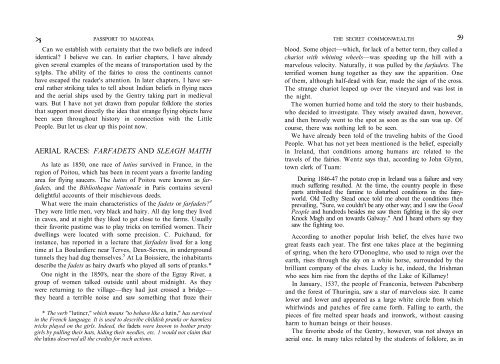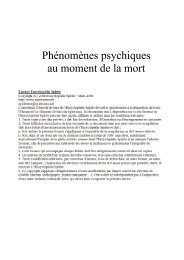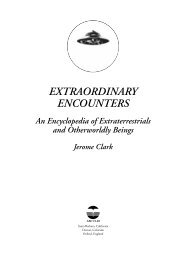Create successful ePaper yourself
Turn your PDF publications into a flip-book with our unique Google optimized e-Paper software.
s PASSPORT TO MAGONIA THE SECRET COMMONWEALTH 59<br />
Can we establish with certainty that the two beliefs are indeed<br />
identical? I believe we can. In earlier chapters, I have already<br />
given several examples of the means of transportation used by the<br />
sylphs. The ability of the fairies to cross the continents cannot<br />
have escaped the reader's attention. In later chapters, I have several<br />
rather striking tales to tell about Indian beliefs in flying races<br />
and the aerial ships used by the Gentry taking part in medieval<br />
wars. But I have not yet drawn from popular folklore the stories<br />
that support most directly the idea that strange flying objects have<br />
been seen throughout history in connection with the Little<br />
People. But let us clear up this point now.<br />
AERIAL RACES: FARFADETS AND SLEAGH MAITH<br />
As late as 1850, one race of lutins survived in France, in the<br />
region of Poitou, which has been in recent years a favorite landing<br />
area for flying saucers. The lutins of Poitou were known as farfadets,<br />
and the Bibliotheque Nationale in Paris contains several<br />
delightful accounts of their mischievous deeds.<br />
What were the main characteristics of the fadets or farfadets? 4<br />
They were little men, very black and hairy. All day long they lived<br />
in caves, and at night they liked to get close to the farms. Usually<br />
their favorite pastime was to play tricks on terrified women. Their<br />
dwellings were located with some precision. C. Puichaud, for<br />
instance, has reported in a lecture that farfadets lived for a long<br />
time at La Boulardierc near Tcrves, Deux-Sevres, in underground<br />
tunnels they had dug themselves. 5 At La Boissiere, the inhabitants<br />
describe the fadets as hairy dwarfs who played all sorts of pranks.*<br />
One night in the 1850's, near the shore of the Egray River, a<br />
group of women talked outside until about midnight. As they<br />
were returning to the village—they had just crossed a bridge—<br />
they heard a terrible noise and saw something that froze their<br />
* The verb "lutincr," which means "to behave like a lutin," has survived<br />
in the French language. It is used to describe childish pranks or harmless<br />
tricks played on the girls. Indeed, the fadets were known to bother pretty<br />
girls by pulling their hats, hiding their needles, etc. 1 would not claim that<br />
the lutins deserved all the credits for such actions.<br />
blood. Some object—which, for lack of a better term, they called a<br />
chariot with whining wheels—was speeding up the hill with a<br />
marvelous velocity. Naturally, it was pulled by the farfadets. The<br />
terrified women hung together as they saw the apparition. One<br />
of them, although half-dead with fear, made the sign of the cross.<br />
The strange chariot leaped up over the vineyard and was lost in<br />
the night.<br />
The women hurried home and told the story to their husbands,<br />
who decided to investigate. They wisely awaited dawn, however,<br />
and then bravely went to the spot as soon as the sun was up. Of<br />
course, there was nothing left to be seen.<br />
We have already been told of the traveling habits of the Good<br />
People. What has not yet been mentioned is the belief, especially<br />
in Ireland, that conditions among humans arc related to the<br />
travels of the fairies. Wentz says that, according to John Glynn,<br />
town clerk of Tuam:<br />
During 1846-47 the potato crop in Ireland was a failure and very<br />
much suffering resulted. At the time, the country people in these<br />
parts attributed the famine to disturbed conditions in the fairyworld.<br />
Old Tedhy Stead once told me about the conditions then<br />
prevailing, "Sure, we couldn't be any other way; and I saw the Good<br />
People and hundreds besides me saw them fighting in the sky over<br />
Knock Magh and on towards Galway." And I heard others say they<br />
saw the fighting too.<br />
According to another popular Irish belief, the elves have two<br />
great feasts each year. The first one takes place at the beginning<br />
of spring, when the hero O'Donoglme, who used to reign over the<br />
earth, rises through the sky on a white horse, surrounded by the<br />
brilliant company of the elves. Lucky is he, indeed, the Irishman<br />
who sees him rise from the depths of the Lake of Killarney!<br />
In January, 1537, the people of Franconia, between Pabcnberp<br />
and the forest of Thuringia, saw a star of marvelous size. It came<br />
lower and lower and appeared as a large white circle from which<br />
whirlwinds and patches of fire came forth. Falling to earth, the<br />
pieces of fire melted spear heads and ironwork, without causing<br />
harm to human beings or their houses.<br />
The favorite abode of the Gentry, however, was not always an<br />
aerial one. In many talcs related by the students of folklore, as in





